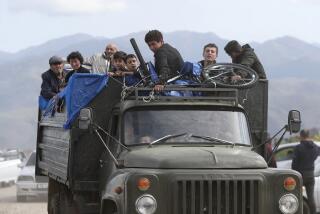‘Gooney Birds’ Still in Israeli Air Force : Aircraft: Twenty World War II-vintage Douglas DC-3s remain operational. They are used to transport troops and material, train pilots, drop paratroopers.
- Share via
AIR BASE IN CENTRAL ISRAEL — It’s a sight from the heyday of the propeller plane, a dozen Douglas DC-3s lined up on a tarmac like old gray geese, ready to barnstorm their way into the next century.
These grandfathers of aviation belong to the Israeli air force, which owns--and still operates--one of the world’s largest collections of DC-3s, the twin-engine workhorses of World War II nicknamed “gooney birds” by American pilots.
Why would a modern air force maintain a fleet of 57-year-old planes when it has F-15s and Apache helicopters?
Because this is an air force proud of its ability to improvise and defy the rules. Also, the DC-3, or Dakota as Israelis know it, is cheap to run, does the job without a hitch, and keeps pilots in touch with the simple, uncomplicated joy of flight.
Anyway, their pilots say, the only replacement for a DC-3 is another DC-3.
They stand wingtip to wingtip on the tarmac at this air base in central Israel, their gentle, reassuring contours etched against a blue Mediterranean sky. They are fueled and as ready to go as they were 50 years ago.
Once airborne for a recent training flight, the DC-3 bucked along at 135 m.p.h., its piston engines sobbing and heaving. A young lieutenant pilot held tightly to the wheel of the plane--circa 1942--as it bounced and jiggled.
“You need a lot of knuckle power to fly this one,” he says.
Yael Rom laughed out loud. “It’s a different generation, what can I tell you,” she shouts over the roar of the engines.
Rom, now a matronly, white-haired 59, was a legend in her time. She was the Israeli air force’s first and only woman pilot, and she flew the lead plane in the paratroop drop that was crucial to the 1956 Sinai Campaign.
“It is not true that I flew because there were not enough pilots,” Rom said. “They chose me because I was trained for it.”
Rom graduated No. 2 from flight school and continued to fly as a reservist until 1967. Now she had come along for the ride, along with another DC-3 veteran, Lt. Col. (ret.) Uri Biham.
Israel has 20 operational DC-3s today, according to the Jaffee Center for Strategic Studies.
“This is not a museum. It’s not a junkyard,” said the DC-3 squadron commander, a lieutenant colonel whose name is classified.
The DC-3 first flew in 1935, and 10,629 were built, so that by the time production ended in 1945, it was one of the most-produced aircraft of all time.
The C-47, as the military version is called, saw its prime as the Allied transport plane of the World War II, then made a smooth transition to commercial traffic where it dominated in the 1950s.
DC-3s have flown more miles, hauled more freight, carried more passengers than any other aircraft.
Israel obtained some surplus C-47s in the late 1940s and early 1950s and they have participated in every Arab-Israeli war.
The Haaretz newspaper, quoting foreign sources, recently reported that they were flying over southern Lebanon using electronics to detonate guerrilla bombs on the ground. The military refused to comment.
Today, they are still used as to transport troops and materiel, train pilots and drop paratroopers.
The anonymous squadron commander said its operating costs are about one-tenth that of modern planes.
One crewman remarked how the DC-3 is a true “fly-by-wire” operation. He opened the back hatch to reveal the cables and pulleys that control the fin and stabilizer.
“It’s just like a car,” he says. “You fill it with gas, check the oil and that’s it.”
In 1984, the U.S. Air Force finally mothballed the C-47. But most Third World air forces still use a DC-3 or two, as do small airlines and freight haulers.
Don Hanson, spokesman for the Douglas Aircraft Co. in Long Beach, Calif., estimated 1,500 are still flying somewhere in the world.
“We have never tried to put an end date on the DC-3s,” Hanson said. “The FAA has said that their air-worthiness depends on the actual condition of each individual plane. And the fact is that a lot of them are restored, and in good enough condition, that even today they’re being re-engined with new turboprop engines and they’re coming back as essentially new airplanes.”
The Israelis say their own aircraft industry supplies the spare parts they need. The squadron commander said crews from Holland and elsewhere have come to Israel to learn maintenance methods.
“Even a C-47 needs parts once in a while,” said Israel Aircraft Industries spokesman Phil Herman. “As long as the air force wants to fly them, we’ll supply the parts. If we can’t make them, we’ll procure them.”
The squadron commander said the DC-3, unlike jets, forsakes pressurized cabins and supersonic speed and engages with nature, which is why jet pilots will fly the lumbering planes for the sheer joy of it.
DC-3 missions differ somewhat from Rom’s flying days, when she rigged her plane to carry a Jeep strapped to its belly. “Stupid me, I flew with it,” she said.
“Each of those planes was something else,” Rom added, shaking her head. “Each with its own quirks.”
More to Read
Sign up for Essential California
The most important California stories and recommendations in your inbox every morning.
You may occasionally receive promotional content from the Los Angeles Times.













